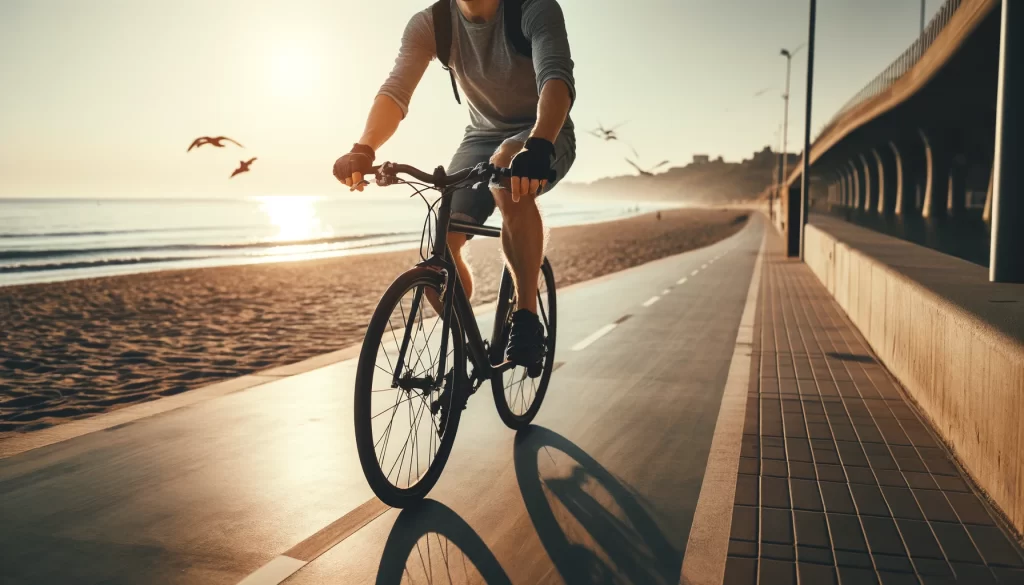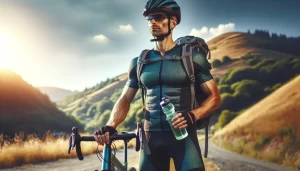Cycling gloves are more than just a stylish accessory; they are a vital piece of gear for any cyclist looking to improve comfort and performance on their rides. Whether you’re pedaling through crisp morning air or challenging yourself on rugged mountain trails, the right pair of gloves can protect your hands from the elements and enhance your grip and control over the bicycle.
As such, choosing the ideal gloves is not just about fashion—it’s about integrating practicality with your overall cycling experience. When embarking on the journey to find the perfect cycling gloves, it’s crucial to consider several factors that affect their performance and suitability.
From the material and padding to the fit and specific features like touchscreen compatibility, each aspect plays a significant role in how the gloves will support your cycling adventures.
This guide aims to arm you with all the necessary information to make an informed choice, ensuring that your gloves are not just an afterthought but a pivotal part of your cycling gear. Keep reading to discover how to select gloves that align perfectly with your cycling needs and preferences.

Image Source: Image Generated With DALL-E on ChatGPT
Benefits of Wearing Cycling Gloves
Cycling gloves are not just an accessory; they are essential for both comfort and protection. They help in absorbing road vibrations, thus reducing fatigue on long rides. Gloves protect your hands in case of a fall and offer a better grip on the handlebars, especially when you’re sweating.
They can also shield your skin from harmful UV rays during sunny rides. Additionally, cycling gloves can prevent blisters and reduce the pressure on your nerves, which can prevent numbness and tingling associated with longer rides.
Tips for Using Cycling Gloves:
- Choose the Right Fit: Ensure that the gloves fit snugly but don’t constrict circulation.
- Select Appropriate Padding: Opt for more padded gloves for rough terrains and less padding for smoother, road cycling to maintain handlebar feel.
- Consider Wrist Support: Some gloves offer additional wrist support which can be beneficial if you have wrist pain or previous injuries.
- Maintenance: Regularly wash your gloves to remove sweat and bacteria to extend their life and maintain hygiene.
- Seasonal Adaptation: Use lighter, breathable gloves for summer and insulated, waterproof ones for winter riding.
Cycling Gloves for Different Climates
Selecting the right cycling gloves for varying climates is crucial to enhance your riding experience. For warm climates, gloves should be lightweight and highly breathable to keep hands cool and dry.
In colder weather, gloves need to be insulated yet flexible, to keep hands warm without compromising mobility. For rainy conditions, water-resistant or waterproof gloves are essential to maintain grip and comfort. Gloves with longer cuffs can offer better protection against the elements and improve overall warmth and dryness.
Choosing Cycling Gloves for Different Weather Conditions:
- Warm Weather Gloves: Look for gloves with mesh or ventilated fabrics and minimal padding for summer riding.
- Cold Weather Gloves: Choose gloves with thermal insulation, such as fleece lining, and make sure they offer windproof and waterproof properties.
- Wet Conditions: Opt for gloves with a waterproof outer layer and a grippy palm material to handle slippery conditions.
- Transition Seasons: In spring and fall, consider gloves that offer a balance of warmth and breathability.
- Sun Protection: For sunny days, select gloves with UV protection to shield your hands from sunburn.
Difference Between Full-Finger and Half-Finger Cycling Gloves
Full-finger and half-finger cycling gloves serve different purposes and suit various cycling environments. Full-finger gloves offer complete coverage, making them ideal for mountain biking or cooler weather. They provide better protection against abrasions and are often equipped with more robust padding.
These gloves also help in maintaining warmth during colder rides. On the other hand, half-finger gloves, also known as fingerless gloves, are preferred for road cycling and warmer weather. They offer enhanced breathability and comfort, allowing more dexterity and cooling, which is beneficial during hot rides.
Choosing Between Full-Finger and Half-Finger Cycling Gloves:
- Consider the Riding Style: Full-finger for mountain and rough terrain, half-finger for road and casual biking.
- Assess the Weather Conditions: Full-finger for cold and wet conditions, half-finger for warm and dry.
- Evaluate Comfort and Dexterity: Half-finger gloves offer better dexterity, which might be preferable for those who need to manipulate gears or use a smartphone during rides.
- Protection Needs: Full-finger gloves provide a higher level of protection against cuts and bruises.
- Personal Preference: Ultimately, the choice might also come down to what feels more comfortable and suitable for your cycling habits.
How to Care for and Wash Cycling Gloves
Proper care and cleaning of cycling gloves are essential to extend their lifespan and maintain their effectiveness. Firstly, always follow the manufacturer’s instructions for washing, which are typically found on the tag.
Most cycling gloves can be washed in a machine on a gentle cycle with cold water, but hand washing is often recommended to prevent damage. Use mild soap and avoid bleach and fabric softeners, which can degrade the material and padding of the gloves. Air drying is preferred, as high heat from a dryer can cause the gloves to shrink or warp.
Tips for Maintaining and Washing Cycling Gloves:
- Frequency of Washing: Wash your gloves regularly, especially if they begin to smell or after muddy rides.
- Hand Wash Technique: Use lukewarm water and a small amount of mild detergent. Gently scrub the gloves, then rinse thoroughly.
- Machine Washing: If machine washing, put the gloves in a mesh laundry bag to prevent snagging and tangling with other garments.
- Drying: Air dry by laying them flat or hanging them up away from direct heat and sunlight.
- Stain Removal: For tough stains, pre-treat with a stain remover before washing. Be gentle to avoid damaging the fabric.
- Storage: Store your gloves in a cool, dry place out of direct sunlight to prevent the materials from deteriorating.
Comparison of Materials: Which Is Best for Cycling Gloves?
When selecting materials for cycling gloves, the choice largely depends on the intended use, weather conditions, and personal preference. Common materials include synthetic leather, genuine leather, mesh, and thermal fabrics. Synthetic leather is durable, provides excellent grip, and is often more affordable and easier to care for than genuine leather.
Genuine leather, on the other hand, offers superior comfort and durability, molding to the shape of the rider’s hands over time. Mesh fabrics are typically used in areas requiring more ventilation, making them ideal for summer gloves where breathability and cooling are priorities. Thermal materials like fleece or insulated synthetics are chosen for cold-weather gloves to provide warmth without sacrificing too much dexterity.
Each material brings its own set of advantages. For instance, synthetic fabrics can include features like water resistance and quick-drying capabilities, essential for rainy or snowy conditions. Conversely, genuine leather tends to perform better in terms of long-term robustness and can offer a more classic aesthetic.
Riders should consider their specific needs such as climate, type of cycling (competitive road racing vs. leisure mountain biking), and how often they ride when choosing their glove material. Ultimately, the best material for cycling gloves is one that aligns with the rider’s environment and riding style, providing the right balance of protection, comfort, and durability.

Image Source: Image Generated With DALL-E on ChatGPT
The Importance of Padding in Cycling Gloves
Padding in cycling gloves plays a critical role in comfort and protection. It serves to absorb vibrations and shocks from the road or trail, which can prevent fatigue and discomfort during long rides. Padding is usually made from foam or gel and is most commonly placed in areas of the palm that bear the brunt of pressure against the handlebars.
For road cyclists, especially those covering long distances or riding on rough surfaces, well-padded gloves can reduce the risk of nerve compression, which leads to numbness and tingling in the hands known as cyclist’s palsy. In contrast, mountain bikers benefit from thicker, more robust padding to protect against impacts and abrasions from falls or brushing against foliage.
However, the amount and type of padding needed can vary based on personal preference and the specifics of the cycling discipline. Too much padding can diminish the feel and control of the bike, which some riders might find undesirable. Conversely, too little padding might not offer enough protection, leading to discomfort and potential injury over time.
Riders need to consider their own needs and trial different types of padding to find what offers the best balance of protection, control, and comfort. As cycling technology advances, manufacturers continue to innovate in padding materials and placement, striving to create the ideal cycling glove for every type of rider and condition.
Frequently Asked Questions: Cycling Gloves
1. How do I choose the right size cycling gloves?
- To ensure a proper fit, measure around the widest part of your hand just below the fingers. Compare this measurement to the sizing chart provided by the glove manufacturer. Gloves should fit snugly without restricting movement or circulation.
2. What type of gloves are best for hot weather?
- For hot weather, look for gloves with breathable materials such as mesh or lightweight synthetic fabrics. Gloves with less padding and fingerless designs can also help keep your hands cooler.
3. Are there specific gloves for winter cycling?
- Yes, winter cycling gloves should be insulated and water-resistant to keep your hands warm and dry. Look for gloves with thermal materials and consider features like extended cuffs to block cold air.
4. Can I use touchscreen devices with my cycling gloves?
- Many modern cycling gloves include touchscreen-compatible fingertips. These allow you to operate GPS devices and smartphones without removing your gloves, which is especially useful in cold weather.
5. How often should I replace my cycling gloves?
- The lifespan of cycling gloves varies based on usage and quality. Inspect your gloves regularly for signs of wear, such as thinning padding or tears. Generally, replacing your gloves every season or two is a good practice if you ride frequently.
6. Do I really need cycling gloves for short rides?
- While they may not be essential for very short, casual rides, cycling gloves provide benefits like improved grip and vibration reduction that can enhance comfort and control, even on short trips.
7. What is the difference between gel and foam padding?
- Gel padding tends to absorb vibrations more effectively and is durable, making it suitable for longer rides or rough terrains. Foam padding is lighter and can be more breathable but might compress more quickly over time.
Choosing the right cycling gloves is crucial for both comfort and performance on the bike. Gloves not only protect your hands in various weather conditions but also help in reducing fatigue by absorbing road vibrations.
When selecting gloves, consider the type of cycling you’ll be doing, the weather conditions you’ll face, and your personal comfort preferences. It’s worth investing in quality gloves that meet your specific needs, as they can significantly enhance your riding experience.
Remember, the best cycling glove for you is one that fits well, provides the necessary protection and comfort, and suits the climate in which you’ll be riding. Don’t hesitate to try different styles and padding types to find what works best for your hands. With the right pair of gloves, you can enjoy longer rides with greater comfort and control, making your cycling adventures all the more enjoyable.
Did you like the article? Be sure to check out more content like this in the Equipment And Accessories category, or see more related content below.






